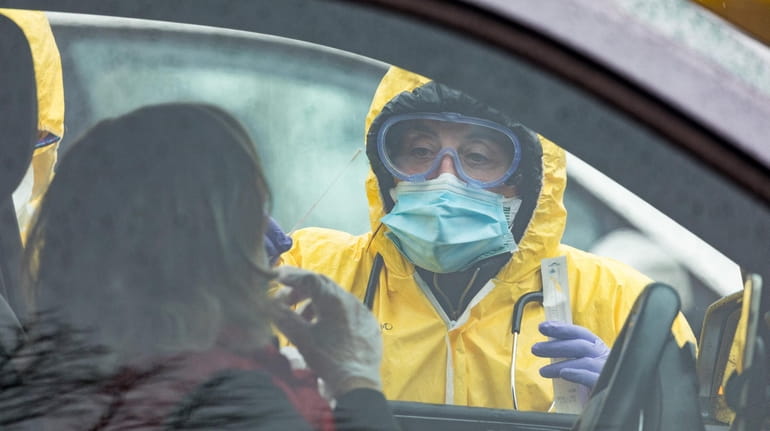Newsday analysis looks at number of cases, deaths on LI

Medical staff administer COVID-19 testing by appointment at ProHEALTH Urgent Care in Jericho Saturday. Credit: Barry Sloan
Long Islanders are more likely to have been tested for COVID-19 than people in South Korea, where aggressive early testing is credited with helping slow the spread of the pandemic there, a Newsday analysis shows.
As of Saturday, Nassau County had tallied 1,058 tests per 100,000 people, and Suffolk County had 812, while South Korea had 752 per 100,000, the analysis shows. New York City had 781.
The types of people tested, the timing of the tests and governmental responses to the findings are factors that may help explain why Long Island on Saturday passed South Korea in the total number of confirmed coronavirus cases, despite Nassau and Suffolk counties having a population 18 times smaller.
The Island’s count has topped 9,600 compared with 9,478 in South Korea, according to New York State and the Johns Hopkins Coronavirus Resource Center.
South Korea and the United States reported the first confirmed COVID-19 case on the same day, Jan. 21, according to the Johns Hopkins center. But South Korea moved quickly, and early, to do targeted testing, such as at a megachurch in the city of Daegu, to where many of the country’s cases are traced, said Dr. Bettina Fries, chief of the infectious diseases division at Stony Brook Medicine.
“They nailed down every member of that church,” she said.
South Korea also quickly opened testing to private labs, a move that the U.S. government didn’t make for weeks.
“We needed a lot more tests from the beginning on,” Fries said. “By the time we got around to testing, it had spread already.”
Testing has a much greater impact if it is done early, she said. In contrast, on Long Island, testing initially was very limited.
The testing rate in Nassau County is likely higher than in Suffolk because “Nassau in the early days had twice as many cases as we did,” Fries said, referring to Suffolk.
The virus may have spread more widely in Nassau in part because the county is close to major airports, and because “it’s a wealthy community and people travel more,” making it more likely they were exposed in countries like Italy, said Dr. Jacqueline Moline, chair of occupational medicine, epidemiology and prevention at North Shore University Hospital in Manhasset.
Expanded testing would still be helpful, Moline said. Many people who carry the virus either are asymptomatic or have only mild symptoms, and if those people are tested and find out they are COVID-19-positive, they can quarantine themselves and inform those they were in contact with, she said.
“It’s only the people who are super-symptomatic who are getting tested now” on Long Island, she said.
Long-term, wider testing — especially important if the virus continues to spread for many months — also would give epidemiologists a better idea of COVID-19’s prevalence and who it has affected most severely, said Danielle Ompad, an associate professor of epidemiology at the NYU School of Global Public Health in Manhattan.
Newsday also analyzed deaths per 100,000 in New York and in Wuhan, China, from where the pandemic emerged.
Wuhan has a much higher rate of deaths per 100,000 residents than Long Island and the rest of New York. It is 23 deaths per 100,000 in Wuhan, versus 2.5 on Long Island.
But, Ompad said, in New York, “There are more deaths to be counted because our epidemic curve hasn’t peaked yet and it hasn’t come all the way down. In terms of where we are in our epidemic, we are behind where Wuhan is.”
How high the death rate rises depends on factors such as whether there are enough ventilators for the expected surge in New York cases in the coming weeks, Ompad said.

